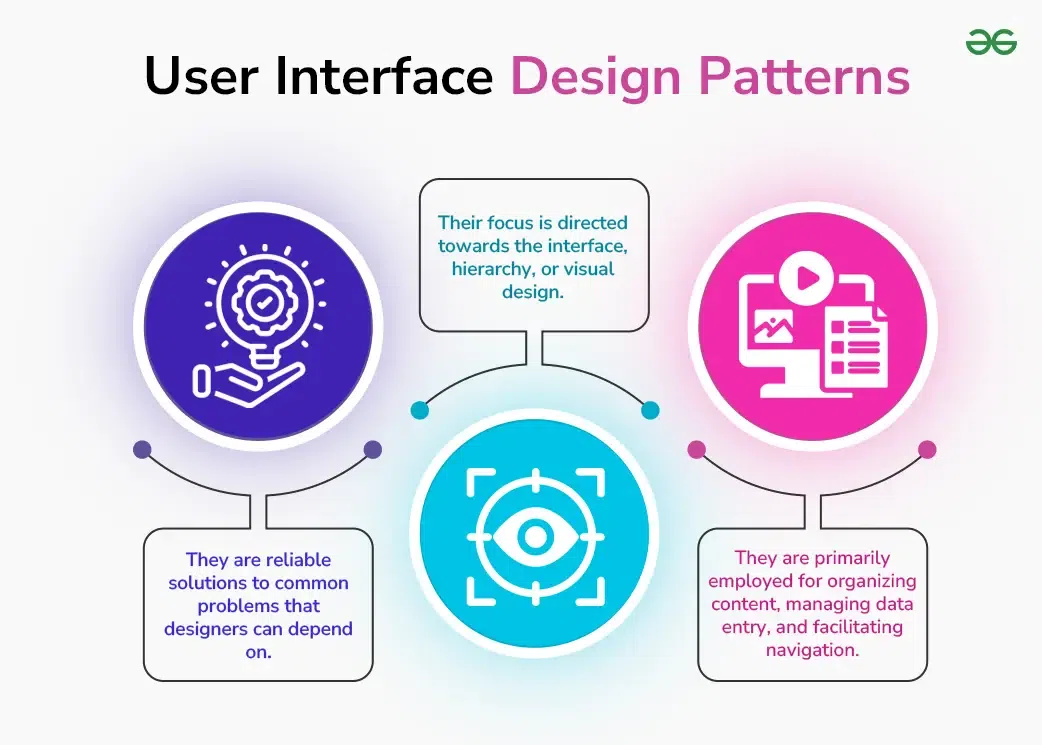
User Interface (UI) Design Patterns are essential tools that help designers create effective and user-friendly interfaces. These patterns are common solutions to common design problems, making it easier to build websites and apps that users can navigate easily. In this article, we’ll explore what UI Design Patterns are, how the UI Design Pattern Model works, and why they are crucial for creating great user experiences.
UI Design Patterns are reusable solutions to common design problems. They provide a set of best practices and guidelines that designers can follow to solve specific problems in a user interface. These patterns help create a consistent and intuitive experience for users, making it easier for them to interact with a website or app.
The importance of UI design patterns is as follows:
The elements which are used in the UI design pattern are as follows:
The User Interface model consists of interconnected elements i.e. problem, solution, usage, and benefits – forming a cohesive approach to solving challenges in user interface.

User Interface Design Patterns
The UI Design Pattern Model is a framework that helps designers identify and implement the right design patterns for their projects. This model includes:
The common UI design patterns which are used in web application are as follows:-
These patterns are like ready-made solutions to common design challenges, making it easier for designers to create interfaces that users find familiar and easy to use.
A dark design pattern is like a tricky design on a website or app that tries to make you do things you might not want to, such as adding extra purchases or subscribing to ongoing payments.
In simple words we say that, it is just like tricky tactics some websites use to fool you. They might hide costs or make it tricky to cancel things on purpose. Unlike regular design mistakes, dark patterns are intentionally created. The people making them know a lot about how our minds work, but they’re not looking out for what’s best for the user. So, it’s like using the same design rules that make things easy to use, but for the wrong reasons. Always be on the lookout for these sneaky tactics!
Using UI design patterns effectively can greatly improve the usability and consistency of your projects. Here’s how to incorporate them into your design process:
Understand different UI design patterns by studying successful apps and websites. Familiarize yourself with common patterns and how they solve specific design problems.
Study the patterns carefully and adapt them to fit the specific needs of your project. Customize the patterns to align with your design goals and user requirements.
Before finalizing your design, test it with real users. This ensures that the UI design patterns are user-friendly and effective in practice. Gather feedback and make necessary adjustments.
Identify which patterns are suitable for your project. Not every pattern fits every situation, so choose wisely based on the context and goals of your design.
Creating your own design pattern library can streamline your design process and improve consistency across your projects. Here’s a step-by-step guide to help you build your library:
Recognize the recurring design issues you face in your projects. Pay attention to problems that frequently arise and need consistent solutions.
Come up with effective solutions for these challenges. Use your experience and research to create practical and efficient design patterns.
Create clear and comprehensive documentation for each pattern. Include detailed explanations, visual examples, and guidelines on how to use the patterns effectively.
Validate your patterns through usability testing. Gather feedback from real users to refine and improve your design patterns, ensuring they work well in practice.
Structure your patterns into a library. This could be a digital document, a folder with organized files, or even a dedicated section in your design software. Make sure it’s easy to navigate and accessible to your team.
UI design patterns are essential for creating cohesive, user-friendly interfaces. They save time, enhance user experience, and ensure consistency. However, it’s crucial to avoid dark patterns and focus on ethical design practices. Creating a personal pattern library involves understanding common challenges, developing solutions, and rigorously testing them to ensure their effectiveness.
UI Design Patterns are reusable solutions to common design problems in user interfaces.
They help create consistent and user-friendly interfaces, making it easier for users to navigate and interact with a website or app.
It is a framework that includes identifying the problem, understanding the context, applying a solution, and providing examples.
One example is the “Hamburger Menu,” which is a common solution for hiding navigation menus on mobile devices.
They provide familiar and intuitive solutions, reducing the learning curve and making interactions smoother for users.